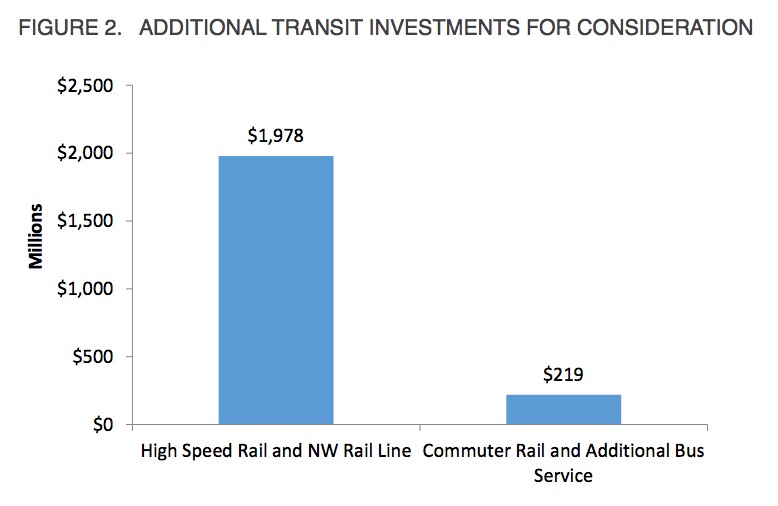CoPIRG FOUNDATION
SOUTHWEST ENERGY EFFICIENCY PROJECT
How Much Colorado Needs To Invest & Why It Is The Right Path Forward
Executive Summary
Transit, walking and biking are critical components of a 21st century transportation system in Colorado but have been underfunded for decades. Without significant investments in transit, biking and pedestrian services and infrastructure, Colorado will not be able to meet the demands and challenges of our shifting demographics and growing population, and will miss out on the many benefits transit, walking and biking provide.
Colorado needs to increase investments in transit, walking and biking by $1.05 billion dollars per year over the next 25 years to ensure every Coloradan in our towns and cities experiences the multitude of benefits that come from good access to adequate sidewalks, safe bicycle infrastructure including safe shoulders on rural highways, and good transit service within cities as well as a comprehensive statewide, bus-based, intercity transit system.
The benefits of this investment are immense. Transit, walking, and biking are critical to increase the safety, accessibility, and affordability of our transportation system and reduce the negative impacts on our health, local economy, environment and quality of life from a mostly single-mode, car-oriented transportation system.
Coloradans from all backgrounds and all parts of the state will benefit whether it is a family in Denver who can ride a bus to the ski areas; or an aging resident of Craig who needs to get to a critical medical appointment 100 miles away without a car; or for a child in Greeley to safely walk to school; or for a bicyclist in Longmont to commute to Boulder; or for residents of Aurora to have access to employment opportunities from Louisville to Highlands Ranch riding fast and frequent bus rapid transit.
An increased investment in transit, biking and walking can save a Coloradan thousands of dollars each year by providing more affordable options for travel and reducing the need to own a car. Expanded and improved transit service combined with bike and walking investments increase the accessibility of employment opportunities, schools, medical services, grocery stores and entertainment for the nearly 10% of Coloradans of driving age who do not have a driver’s license and the hundreds of thousands of additional Coloradans who want to get around without car.
Traveling as a pedestrian, bicyclist or transit rider provides significant health benefits by reducing air pollution like greenhouse gas emissions and smog forming particulates. These modes of travel also offer a way to combat obesity and improve individual health by providing active transportation options. Transit, walking, and biking can play a big role in shorter trips of 3 miles or less, which make up a majority of the total trips along the Colorado Front Range.
 Walkability, bikeability and transit-oriented areas provide benefits to local businesses. Better pedestrian, bicycle, and transit services and infrastructure are critical tools for eliminating transportation-related crashes and fatalities.
Walkability, bikeability and transit-oriented areas provide benefits to local businesses. Better pedestrian, bicycle, and transit services and infrastructure are critical tools for eliminating transportation-related crashes and fatalities.
With 2.4 million more people pouring into Colorado in the next 25 years, transit, biking and walking are important transportation options to combat congestion.
Finally, we need to increase investments in transit, walking and biking because that is what Coloradans say they want in polls and surveys, whether it is the swelling Millennial population or the aging Baby Boomers who are found not just in urban areas but in rural communities across the state.
This will require a partnership between local, state and federal government and the private sector to both reallocate existing funds and generate new money for multimodal transportation needs.
Transit, Biking and Walking Investments Needed Over the Next 25 Years
An additional $1.05 billion dollars per year in transit, walking and biking builds a complete sidewalk system in cities and towns across Colorado; brings intracity bike infrastructure up to the standards of the best communities in Colorado and adds regional bicycle connections and safer biking options along rural highway shoulders; and would bring good transit service to the major Colorado population centers, provide fare-free service in the Denver metro area, complete over a dozen local bus rapid transit lines, and build out a comprehensive statewide, intercity transit system including dozens of buses from Denver to ski areas and demand response bus service to meet the growing rural transit needs.
Download full version (PDF): Colorado’s Transit, Biking & Walking Needs Over The Next 25 Years
About the CoPIRG Foundation
www.copirgfoundation.org
CoPIRG Foundation is an independent, non-partisan group that works for consumers and the public interest. Through research, public education and outreach, we serve as counterweights to the influence of powerful special interests that threaten our health, safety or well-being.
About the Southwest Energy Efficiency Project (SWEEP)
www.swenergy.org
The Southwest Energy Efficiency Project (SWEEP) is a public interest organization promoting greater energy efficiency in Arizona, Colorado, Nevada, New Mexico, Utah, and Wyoming. Traditionally this is a high growth region where energy efficiency efforts were lagging compared to some other regions, air pollution is a growing concern, and coal-fired power plants provide the majority of electricity supply. Due in large part to the efforts of SWEEP, the region has made great strides in advancing energy efficiency over the past decade. (Scroll down for list of SWEEP accomplishments.)
Tags: CO, colorado, CoPIRG Foundation, Southwest Energy Efficiency Project, SWEEP, Walkability, Walking







 RSS Feed
RSS Feed